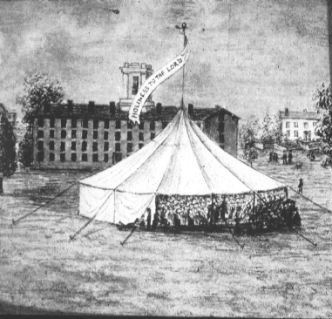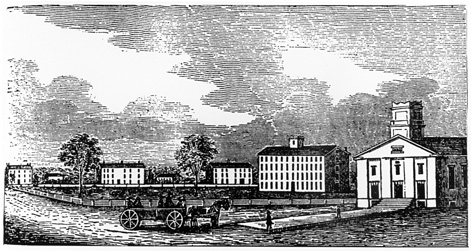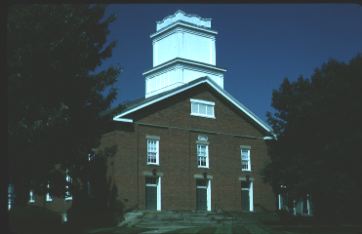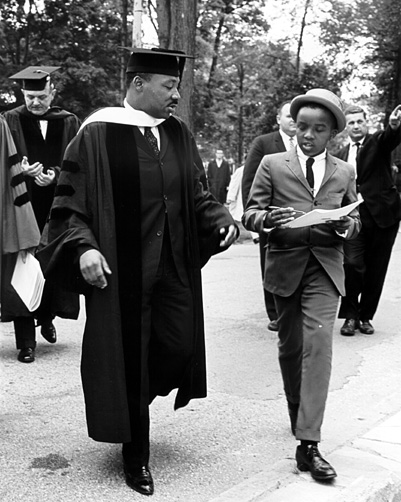It was Sunday, June 17, 1842. A large crowd was gathering across the northwest corner of the campus. The women were dressed in long, dark skirts, with fringed shawls and sunbonnets on their heads. The men wore their Sunday black suits and white shirts with stiff collars. The children, tagging along beside their parents, were dressed exactly like their fathers and mothers. Something important was happening.
The people took their places along the sides of a deep hole. Bricks and stone as well as lumber that had been cut from the nearby forests and farms were piled nearby. Lorain and Main Streets were very dusty and the people who were still coming tried to walk on the boardwalks at the side of the streets.
Tied to the fence surrounding the campus were the horses that some had ridden to town. Cows and chickens roamed lose through the streets.
The crowd gradually quieted down. Led by a bearded man with piercing blue eyes, they sang a hymn. Then Reverend Charles G. Finney prayed for God's blessing on the first church in Oberlin. The cornerstone was laid. The First Congregational Church of Oberlin, the largest building west of the Allegheny Mountains for many years, was officially started.
For about ten years, the Church, or Meeting House, was the only gathering place for the whole town. Before 1844, worshipers had met in Deacon Pease's little cabin, in college buildings, or, during the summer, in a large tent that was erected on the campus. The tent held 3,000 people but sometimes it blew down in a strong wind.

The people of Oberlin worked hard to raise the money for their church. A total of $13,000 was collected. Some people who didn't have money to give, donated materials such as eleven pounds of nails, a cheese, four bushels of apples, a horse wagon, and even two cows. One of the deacons had gathered enough lumber to build a house for himself, but he gave it all to the church instead. Most of the locally-fired bricks came from Pringle Hamilton's farm, just south of town.

At last, in 1844, the building was ready to use. By 1860 the congregation of this church was the largest in the United States.
The church building hasn't changed much in over 150 years. What has changed is the worship service. In those early days, services were held both in the morning and in the afternoon on Sundays. The sermons, preached for many years by Finney, were one or two hours long with the prayers about half as long. Until the organ was installed, a bass viol, horns, and violins provided the music.
The children and their parents always sat in the same pew and were there every Sunday. College students sat in the balcony. In the winter, wood-burning stoves, placed along the walls, upstairs and downstairs, provided the heat. Since there wasn't enough money for carpeting, each family brought its own rug to cover the rough floor.
The church, as a Meeting House, was used for musical programs, political speeches, rallies, and other college programs. A hand-operated fire engine used to be kept in the basement. Preschool classes are still held in the building.
Many famous Americans have come to Oberlin to speak at the First Church Meeting Hall including Frederick Douglass, Mark Twain, Ralph Waldo Emerson, Booker T. Washington, Woodrow Wilson, and Martin Luther King, Jr.


For many years, this First Church was the only church in town. First Church is still a beautiful building and the oldest building in town that is still on its original site.
Today Oberlin has many churches and meeting places where people can worship and where town meetings can be held. In 1995, there were eighteen churches in Oberlin or on the city's outskirts. These churches remind us of the important purposes that Oberlin's founders and its early settlers held for our town.
Why do you think the people of Oberlin worked so hard and gave up so much to build this Meeting House?
Many famous people have spoken in Oberlin. What well-known person would you invite to speak at the Meeting House, your church, or another meeting place in Oberlin today? Why would you invite this person? What do you imagine their message would be?
Oberlin: Yesterday, Today, Tomorrow Home
Page | Table of Contents | ![]()
![]()